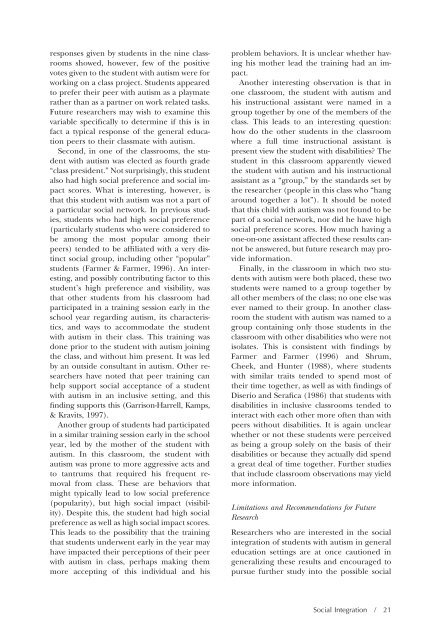Education and Training in Developmental Disabilities - Division on ...
Education and Training in Developmental Disabilities - Division on ...
Education and Training in Developmental Disabilities - Division on ...
Create successful ePaper yourself
Turn your PDF publications into a flip-book with our unique Google optimized e-Paper software.
esp<strong>on</strong>ses given by students <str<strong>on</strong>g>in</str<strong>on</strong>g> the n<str<strong>on</strong>g>in</str<strong>on</strong>g>e classrooms<br />
showed, however, few of the positive<br />
votes given to the student with autism were for<br />
work<str<strong>on</strong>g>in</str<strong>on</strong>g>g <strong>on</strong> a class project. Students appeared<br />
to prefer their peer with autism as a playmate<br />
rather than as a partner <strong>on</strong> work related tasks.<br />
Future researchers may wish to exam<str<strong>on</strong>g>in</str<strong>on</strong>g>e this<br />
variable specifically to determ<str<strong>on</strong>g>in</str<strong>on</strong>g>e if this is <str<strong>on</strong>g>in</str<strong>on</strong>g><br />
fact a typical resp<strong>on</strong>se of the general educati<strong>on</strong><br />
peers to their classmate with autism.<br />
Sec<strong>on</strong>d, <str<strong>on</strong>g>in</str<strong>on</strong>g> <strong>on</strong>e of the classrooms, the student<br />
with autism was elected as fourth grade<br />
“class president.” Not surpris<str<strong>on</strong>g>in</str<strong>on</strong>g>gly, this student<br />
also had high social preference <str<strong>on</strong>g>and</str<strong>on</strong>g> social impact<br />
scores. What is <str<strong>on</strong>g>in</str<strong>on</strong>g>terest<str<strong>on</strong>g>in</str<strong>on</strong>g>g, however, is<br />
that this student with autism was not a part of<br />
a particular social network. In previous studies,<br />
students who had high social preference<br />
(particularly students who were c<strong>on</strong>sidered to<br />
be am<strong>on</strong>g the most popular am<strong>on</strong>g their<br />
peers) tended to be affiliated with a very dist<str<strong>on</strong>g>in</str<strong>on</strong>g>ct<br />
social group, <str<strong>on</strong>g>in</str<strong>on</strong>g>clud<str<strong>on</strong>g>in</str<strong>on</strong>g>g other “popular”<br />
students (Farmer & Farmer, 1996). An <str<strong>on</strong>g>in</str<strong>on</strong>g>terest<str<strong>on</strong>g>in</str<strong>on</strong>g>g,<br />
<str<strong>on</strong>g>and</str<strong>on</strong>g> possibly c<strong>on</strong>tribut<str<strong>on</strong>g>in</str<strong>on</strong>g>g factor to this<br />
student’s high preference <str<strong>on</strong>g>and</str<strong>on</strong>g> visibility, was<br />
that other students from his classroom had<br />
participated <str<strong>on</strong>g>in</str<strong>on</strong>g> a tra<str<strong>on</strong>g>in</str<strong>on</strong>g><str<strong>on</strong>g>in</str<strong>on</strong>g>g sessi<strong>on</strong> early <str<strong>on</strong>g>in</str<strong>on</strong>g> the<br />
school year regard<str<strong>on</strong>g>in</str<strong>on</strong>g>g autism, its characteristics,<br />
<str<strong>on</strong>g>and</str<strong>on</strong>g> ways to accommodate the student<br />
with autism <str<strong>on</strong>g>in</str<strong>on</strong>g> their class. This tra<str<strong>on</strong>g>in</str<strong>on</strong>g><str<strong>on</strong>g>in</str<strong>on</strong>g>g was<br />
d<strong>on</strong>e prior to the student with autism jo<str<strong>on</strong>g>in</str<strong>on</strong>g><str<strong>on</strong>g>in</str<strong>on</strong>g>g<br />
the class, <str<strong>on</strong>g>and</str<strong>on</strong>g> without him present. It was led<br />
by an outside c<strong>on</strong>sultant <str<strong>on</strong>g>in</str<strong>on</strong>g> autism. Other researchers<br />
have noted that peer tra<str<strong>on</strong>g>in</str<strong>on</strong>g><str<strong>on</strong>g>in</str<strong>on</strong>g>g can<br />
help support social acceptance of a student<br />
with autism <str<strong>on</strong>g>in</str<strong>on</strong>g> an <str<strong>on</strong>g>in</str<strong>on</strong>g>clusive sett<str<strong>on</strong>g>in</str<strong>on</strong>g>g, <str<strong>on</strong>g>and</str<strong>on</strong>g> this<br />
f<str<strong>on</strong>g>in</str<strong>on</strong>g>d<str<strong>on</strong>g>in</str<strong>on</strong>g>g supports this (Garris<strong>on</strong>-Harrell, Kamps,<br />
& Kravits, 1997).<br />
Another group of students had participated<br />
<str<strong>on</strong>g>in</str<strong>on</strong>g> a similar tra<str<strong>on</strong>g>in</str<strong>on</strong>g><str<strong>on</strong>g>in</str<strong>on</strong>g>g sessi<strong>on</strong> early <str<strong>on</strong>g>in</str<strong>on</strong>g> the school<br />
year, led by the mother of the student with<br />
autism. In this classroom, the student with<br />
autism was pr<strong>on</strong>e to more aggressive acts <str<strong>on</strong>g>and</str<strong>on</strong>g><br />
to tantrums that required his frequent removal<br />
from class. These are behaviors that<br />
might typically lead to low social preference<br />
(popularity), but high social impact (visibility).<br />
Despite this, the student had high social<br />
preference as well as high social impact scores.<br />
This leads to the possibility that the tra<str<strong>on</strong>g>in</str<strong>on</strong>g><str<strong>on</strong>g>in</str<strong>on</strong>g>g<br />
that students underwent early <str<strong>on</strong>g>in</str<strong>on</strong>g> the year may<br />
have impacted their percepti<strong>on</strong>s of their peer<br />
with autism <str<strong>on</strong>g>in</str<strong>on</strong>g> class, perhaps mak<str<strong>on</strong>g>in</str<strong>on</strong>g>g them<br />
more accept<str<strong>on</strong>g>in</str<strong>on</strong>g>g of this <str<strong>on</strong>g>in</str<strong>on</strong>g>dividual <str<strong>on</strong>g>and</str<strong>on</strong>g> his<br />
problem behaviors. It is unclear whether hav<str<strong>on</strong>g>in</str<strong>on</strong>g>g<br />
his mother lead the tra<str<strong>on</strong>g>in</str<strong>on</strong>g><str<strong>on</strong>g>in</str<strong>on</strong>g>g had an impact.<br />
Another <str<strong>on</strong>g>in</str<strong>on</strong>g>terest<str<strong>on</strong>g>in</str<strong>on</strong>g>g observati<strong>on</strong> is that <str<strong>on</strong>g>in</str<strong>on</strong>g><br />
<strong>on</strong>e classroom, the student with autism <str<strong>on</strong>g>and</str<strong>on</strong>g><br />
his <str<strong>on</strong>g>in</str<strong>on</strong>g>structi<strong>on</strong>al assistant were named <str<strong>on</strong>g>in</str<strong>on</strong>g> a<br />
group together by <strong>on</strong>e of the members of the<br />
class. This leads to an <str<strong>on</strong>g>in</str<strong>on</strong>g>terest<str<strong>on</strong>g>in</str<strong>on</strong>g>g questi<strong>on</strong>:<br />
how do the other students <str<strong>on</strong>g>in</str<strong>on</strong>g> the classroom<br />
where a full time <str<strong>on</strong>g>in</str<strong>on</strong>g>structi<strong>on</strong>al assistant is<br />
present view the student with disabilities? The<br />
student <str<strong>on</strong>g>in</str<strong>on</strong>g> this classroom apparently viewed<br />
the student with autism <str<strong>on</strong>g>and</str<strong>on</strong>g> his <str<strong>on</strong>g>in</str<strong>on</strong>g>structi<strong>on</strong>al<br />
assistant as a “group,” by the st<str<strong>on</strong>g>and</str<strong>on</strong>g>ards set by<br />
the researcher (people <str<strong>on</strong>g>in</str<strong>on</strong>g> this class who “hang<br />
around together a lot”). It should be noted<br />
that this child with autism was not found to be<br />
part of a social network, nor did he have high<br />
social preference scores. How much hav<str<strong>on</strong>g>in</str<strong>on</strong>g>g a<br />
<strong>on</strong>e-<strong>on</strong>-<strong>on</strong>e assistant affected these results cannot<br />
be answered, but future research may provide<br />
<str<strong>on</strong>g>in</str<strong>on</strong>g>formati<strong>on</strong>.<br />
F<str<strong>on</strong>g>in</str<strong>on</strong>g>ally, <str<strong>on</strong>g>in</str<strong>on</strong>g> the classroom <str<strong>on</strong>g>in</str<strong>on</strong>g> which two students<br />
with autism were both placed, these two<br />
students were named to a group together by<br />
all other members of the class; no <strong>on</strong>e else was<br />
ever named to their group. In another classroom<br />
the student with autism was named to a<br />
group c<strong>on</strong>ta<str<strong>on</strong>g>in</str<strong>on</strong>g><str<strong>on</strong>g>in</str<strong>on</strong>g>g <strong>on</strong>ly those students <str<strong>on</strong>g>in</str<strong>on</strong>g> the<br />
classroom with other disabilities who were not<br />
isolates. This is c<strong>on</strong>sistent with f<str<strong>on</strong>g>in</str<strong>on</strong>g>d<str<strong>on</strong>g>in</str<strong>on</strong>g>gs by<br />
Farmer <str<strong>on</strong>g>and</str<strong>on</strong>g> Farmer (1996) <str<strong>on</strong>g>and</str<strong>on</strong>g> Shrum,<br />
Cheek, <str<strong>on</strong>g>and</str<strong>on</strong>g> Hunter (1988), where students<br />
with similar traits tended to spend most of<br />
their time together, as well as with f<str<strong>on</strong>g>in</str<strong>on</strong>g>d<str<strong>on</strong>g>in</str<strong>on</strong>g>gs of<br />
Diserio <str<strong>on</strong>g>and</str<strong>on</strong>g> Serafica (1986) that students with<br />
disabilities <str<strong>on</strong>g>in</str<strong>on</strong>g> <str<strong>on</strong>g>in</str<strong>on</strong>g>clusive classrooms tended to<br />
<str<strong>on</strong>g>in</str<strong>on</strong>g>teract with each other more often than with<br />
peers without disabilities. It is aga<str<strong>on</strong>g>in</str<strong>on</strong>g> unclear<br />
whether or not these students were perceived<br />
as be<str<strong>on</strong>g>in</str<strong>on</strong>g>g a group solely <strong>on</strong> the basis of their<br />
disabilities or because they actually did spend<br />
a great deal of time together. Further studies<br />
that <str<strong>on</strong>g>in</str<strong>on</strong>g>clude classroom observati<strong>on</strong>s may yield<br />
more <str<strong>on</strong>g>in</str<strong>on</strong>g>formati<strong>on</strong>.<br />
Limitati<strong>on</strong>s <str<strong>on</strong>g>and</str<strong>on</strong>g> Recommendati<strong>on</strong>s for Future<br />
Research<br />
Researchers who are <str<strong>on</strong>g>in</str<strong>on</strong>g>terested <str<strong>on</strong>g>in</str<strong>on</strong>g> the social<br />
<str<strong>on</strong>g>in</str<strong>on</strong>g>tegrati<strong>on</strong> of students with autism <str<strong>on</strong>g>in</str<strong>on</strong>g> general<br />
educati<strong>on</strong> sett<str<strong>on</strong>g>in</str<strong>on</strong>g>gs are at <strong>on</strong>ce cauti<strong>on</strong>ed <str<strong>on</strong>g>in</str<strong>on</strong>g><br />
generaliz<str<strong>on</strong>g>in</str<strong>on</strong>g>g these results <str<strong>on</strong>g>and</str<strong>on</strong>g> encouraged to<br />
pursue further study <str<strong>on</strong>g>in</str<strong>on</strong>g>to the possible social<br />
Social Integrati<strong>on</strong> / 21
















